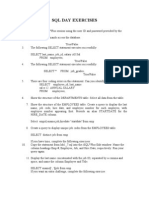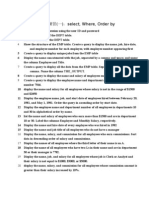0 ratings0% found this document useful (0 votes)
416 viewsExercise 1
This document provides an overview of a lab exercise on simple SQL queries. It lists learning objectives which include writing SELECT statements using clauses like WHERE and ORDER BY, and performing queries to retrieve specific rows and columns based on conditions. It then lists 15 problems as examples to practice writing SQL queries, with the correct SQL query provided below each problem statement. The problems involve selecting data from tables based on conditions on columns like salary, department, date, and using clauses like DISTINCT, BETWEEN and ORDER BY.
Uploaded by
ivkammrzCopyright
© Attribution Non-Commercial (BY-NC)
Available Formats
Download as DOC, PDF, TXT or read online on Scribd
0 ratings0% found this document useful (0 votes)
416 viewsExercise 1
This document provides an overview of a lab exercise on simple SQL queries. It lists learning objectives which include writing SELECT statements using clauses like WHERE and ORDER BY, and performing queries to retrieve specific rows and columns based on conditions. It then lists 15 problems as examples to practice writing SQL queries, with the correct SQL query provided below each problem statement. The problems involve selecting data from tables based on conditions on columns like salary, department, date, and using clauses like DISTINCT, BETWEEN and ORDER BY.
Uploaded by
ivkammrzCopyright
© Attribution Non-Commercial (BY-NC)
Available Formats
Download as DOC, PDF, TXT or read online on Scribd
You are on page 1/ 3
Exercise 1.
Simple SQL Queries
What You Should Be Able to Do
At the end of the lab, you should be able to:
•Code SELECT statements using four clauses
of an SQL SELECT statement.
•Use a SELECT statement to:
-Retrieve all rows of a table
-Retrieve specific columns
-Retrieve rows based on comparisons to numeric or
alphanumeric data
-Retrieve rows based on specific columns containing NULL
values
•Code SELECT statements using keywords
BETWEEN, IN, LIKE and DISTINCT
•Produce a result table whose rows are sorted
in a desired sequence
Introduction
See the data model at the start of this exercise
guide to get the column names and descriptions for each table.
Required Materials
•Student handout
•SQL Reference
Problem List
Problem 1
List employee number, last name, date of birth, and salary for all
employees who make more than $30,000 a year. Sequence the results in
descending order by salary.
Problem 2
List last name, first name, and the department number for all employees.
The listing should be ordered by descending department numbers. Within the
same department, the last names should be sorted in descending order.
Problem 3
List the different education levels in the company in descending order.
List only one occurrence of duplicate result rows.
Problem 4
List employees, by employee number, and their assigned projects, by
project number. Display only those employees with an employee number less
than or equal to 100. List only one occurrence of duplicate rows. Sort the result
rows by employee number.
(Use the EMP_ACT table.)
Problem 5
List last name, salary, and bonus of all male employees.
Problem 6
List last name, salary, and commission for all employees with a salary
greater than $20,000 and hired after 1979.
Problem 7
List last name, salary, bonus, and commission for all employees with a
salary greater than $22,000 and a bonus of $400, or for all employees with a
bonus of $500 and a commission lower than $1,900. The list should be ordered
by last name.
Problem 8
Problem 9
Using the EMP_ACT table, for all projects that have a project number
beginning with AD and have activities 10, 80, and 180 associated with them, list
the following:
•Project number
•Activity number
•Starting date for activity
•Ending date for activity
Order the list by activity number within project number.
Problem 10
List manager number and department number for all departments to
which a manager has been assigned.
The list should be ordered by manager number.
Problem 11
List employee number, last name, salary, and bonus for all employees
that have a bonus ranging from $800 to $1,000.
Sort the report by employee number within bonus, lowest bonus first.
Problem 12
List employee number, last name, salary, and department number for all
employees in departments A00 through C01 (inclusive).
Order the results alphabetically by last name and employee number.
Problem 13
List all projects that have SUPPORT as part of the project name. Order the
results by project number.
Problem 14
List all departments that have a 1 as the middle character in the
department number.
Order the results by department number.
Problem 15
List the last name, first name, middle initial, and salary of the five highest
paid non-manager, non-president employees.
Order the results by highest salary first.
END OF LAB
Problem 1
SELECT EMPNO, LASTNAME, BIRTHDATE, SALARY
FROM EMPLOYEE
WHERE SALARY > 30000
ORDER BY SALARY DESC
Problem 2
SELECT LASTNAME, FIRSTNME, WORKDEPT
FROM EMPLOYEE
ORDER BY WORKDEPT DESC, LASTNAME DESC
Problem 3
SELECT DISTINCT EDLEVEL
FROM EMPLOYEE
ORDER BY EDLEVEL DESC
Problem 4
SELECT DISTINCT EMPNO, PROJNO
FROM EMP_ACT
WHERE EMPNO <= '000100'
ORDER BY EMPNO
Problem 5
SELECT LASTNAME, SALARY, BONUS
FROM EMPLOYEE
WHERE SEX = 'M'
Problem 6
SELECT LASTNAME, SALARY, COMM
FROM EMPLOYEE
WHERE HIREDATE >= '1980-01-01'
AND SALARY > 20000
Problem 7
SELECT LASTNAME, SALARY, BONUS, COMM
FROM EMPLOYEE
WHERE SALARY > 22000 AND BONUS = 400
OR BONUS = 500 AND COMM < 1900
ORDER BY LASTNAME
You might also like
- Microsoft 365 Excel: The Only App That Matters: Calculations, Analytics, Modeling, Data Analysis and Dashboard Reporting for the New Era of Dynamic Data Driven Decision Making & InsightFrom EverandMicrosoft 365 Excel: The Only App That Matters: Calculations, Analytics, Modeling, Data Analysis and Dashboard Reporting for the New Era of Dynamic Data Driven Decision Making & Insight3/5 (2)
- Refutation of - Some Observations, - by Frithjof Schuon - Criticizing René Guénon - Pages 16 To The End.No ratings yetRefutation of - Some Observations, - by Frithjof Schuon - Criticizing René Guénon - Pages 16 To The End.42 pages
- Canon - Elura 10A, 20MCA - Service ManualNo ratings yetCanon - Elura 10A, 20MCA - Service Manual177 pages
- Database Management Systems: Name:Bharti ROLL NO:19570073 Course:Bsc (Hons) Computer ScienceNo ratings yetDatabase Management Systems: Name:Bharti ROLL NO:19570073 Course:Bsc (Hons) Computer Science11 pages
- Database3 - Pratice4 - Adam Nizar KusmaraNo ratings yetDatabase3 - Pratice4 - Adam Nizar Kusmara11 pages
- Exercise Reference Table: Oracle Built in TablesNo ratings yetExercise Reference Table: Oracle Built in Tables1 page
- 11CS DBMS Lab Tasks - 8664723.lab Task 1-8 For 11cs DbmsNo ratings yet11CS DBMS Lab Tasks - 8664723.lab Task 1-8 For 11cs Dbms3 pages
- Database Design - Section 15, Practice Guide Anatomy of A SQL Statement, Try It/Solve It Exercises 2 and 3100% (2)Database Design - Section 15, Practice Guide Anatomy of A SQL Statement, Try It/Solve It Exercises 2 and 33 pages
- Punjab University College of Information Technology (Pucit) : Database Systems Lab 5No ratings yetPunjab University College of Information Technology (Pucit) : Database Systems Lab 52 pages
- OPIM 5272 Fall 2014, University of Connecticut Practice ExamNo ratings yetOPIM 5272 Fall 2014, University of Connecticut Practice Exam8 pages
- Database Management System (DBMS - 204) : Single Row FunctionsNo ratings yetDatabase Management System (DBMS - 204) : Single Row Functions8 pages
- CCS0014 - Lab Exercise 6 - Mendoza - MichaelAngeloMNo ratings yetCCS0014 - Lab Exercise 6 - Mendoza - MichaelAngeloM19 pages
- Union: Course Materials May Not Be Reproduced in Whole or in Part Without The Prior Written Permission of IBMNo ratings yetUnion: Course Materials May Not Be Reproduced in Whole or in Part Without The Prior Written Permission of IBM16 pages
- Practice 5: Introduction To Oracle9i: SQL 5-28No ratings yetPractice 5: Introduction To Oracle9i: SQL 5-283 pages
- Rdbms and SQL: Name:Ibrahim Sameer V S REG NO:17BCA0062100% (1)Rdbms and SQL: Name:Ibrahim Sameer V S REG NO:17BCA006233 pages
- Kumaran Manangatti Dharman Lekha Assignment 6 - Introduction To SQLNo ratings yetKumaran Manangatti Dharman Lekha Assignment 6 - Introduction To SQL7 pages
- DB2 11.1 for LUW: SQL Basic Training for Application DevelopersFrom EverandDB2 11.1 for LUW: SQL Basic Training for Application DevelopersNo ratings yet
- Excel In 7 Days : Master Excel Features & Formulas. Become A Pro From Scratch In Just 7 Days With Step-By-Step Instructions, Clear Illustrations, And Practical ExamplesFrom EverandExcel In 7 Days : Master Excel Features & Formulas. Become A Pro From Scratch In Just 7 Days With Step-By-Step Instructions, Clear Illustrations, And Practical ExamplesNo ratings yet
- Apache Cassandra Developer Associate - Exam Practice TestsFrom EverandApache Cassandra Developer Associate - Exam Practice TestsNo ratings yet
- RD Sharma Solutions For Class 10 Chapter 8 Quadratic Equations PDFNo ratings yetRD Sharma Solutions For Class 10 Chapter 8 Quadratic Equations PDF75 pages
- Technica Notes: Reaction of Aluminum With Sodium Hydroxide Solution As A Source of Hydrogen100% (2)Technica Notes: Reaction of Aluminum With Sodium Hydroxide Solution As A Source of Hydrogen3 pages
- Badri Engineering Corporation: One Stop Shop For All Your Industrial NeedsNo ratings yetBadri Engineering Corporation: One Stop Shop For All Your Industrial Needs2 pages
- Table of Specifications (Tos) : Schools Division of Samar Baras National High SchoolNo ratings yetTable of Specifications (Tos) : Schools Division of Samar Baras National High School7 pages
- Introduction To Oracle Linux - Shell and Command LineNo ratings yetIntroduction To Oracle Linux - Shell and Command Line1 page
- 12 Physics Notes Ch01 Electric Charges and FieldNo ratings yet12 Physics Notes Ch01 Electric Charges and Field3 pages
- Material & Equipment Gate Pass Control No. 0005758641 Status: APPROVEDNo ratings yetMaterial & Equipment Gate Pass Control No. 0005758641 Status: APPROVED1 page
- 215 Cultural Safety Module and Self-Evaluation Assignment 2021 1No ratings yet215 Cultural Safety Module and Self-Evaluation Assignment 2021 115 pages

























































































